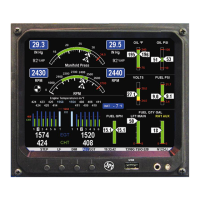
Do you have a question about the J.P. Instruments EDM-960 and is the answer not in the manual?
| Category | Avionics Display |
|---|---|
| Manufacturer | J.P. Instruments |
| Display Type | LCD |
| Resolution | 640 x 480 pixels |
| Alerting | Visual and audible alerts |
| Data Logging | Yes |
| Data Inputs | RS-232 |
| Certifications | FAA TSO |
| Operating Temperature | -20°C to +70°C |
Critical note on RAD installation and verification for FAA certification.
Basics of fuel flow tracking and required refueling input.
Four operating buttons control EDM functions, labels change dynamically.
Overview of screen layout: RPM/MAP, Scanner, and Linear Bar Graphs sections.
Guidance for engine run-up, take-off, cruise, and descent.
Chart of typical measurement values and ranges for aircraft engines.
Chart for diagnosing engine problems based on display symptoms and causes.
Details on the four front panel operating buttons and their functions.
Procedure for accessing Hobbs time readings.
Manual adjustment of display brightness.
How to activate and use Automatic Scanner Mode.
How to activate and use Manual Mode to lock onto specific measurements.
General explanation of LeanFind, pre-leaning, and mode activation.
Detailed steps for Rich of Peak detection and mixture finalization.
Detailed steps for Lean of Peak detection and mixture finalization.
Procedures for Lean of Peak and leaning turbocharged engines.
Importance of accurate fuel flow measurement and EDM fuel flow option.
Procedure for entering fuel added upon startup.
Describes the priority order for non-primary alarms.
Steps to download recorded data to a USB flash drive.
How to view downloaded data using PC software.
How to enter and navigate pilot programming mode for initial setup.
Essential calibration process for the fuel level feature.
Capturing sender readings at calibration points using EDM as meter.
Entering and editing fuel level calibration data in the Fuel Table Editor.
Importance of avoiding rapid cylinder cooling to prevent damage.
Supported GPS data formats for EDM input.
Interface connections for GPS models.
Overview, disclaimer, editor start, and basic gauge management.
Configuring gauge range, alarm limits, color bands, and options.
Modifying aircraft info, engine cylinders, fuel units, tank sizes, channels, and alarms.
Restoring EDM to previous or factory default configurations.
